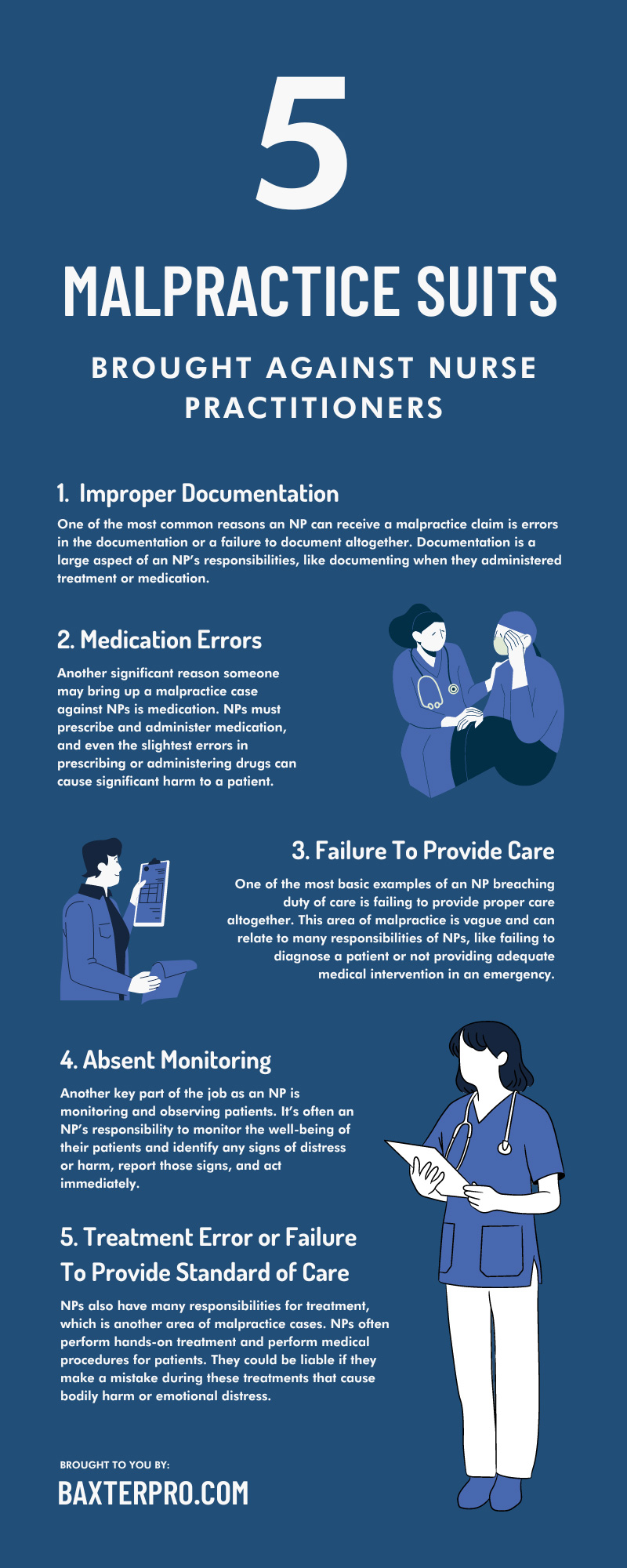Malpractice cases are an unfortunate part of the job of every health-care provider, including nurse practitioners. Below, we’ll explain the elements of medical malpractice and discuss some common examples of malpractice suits brought against nurse practitioners.
The Elements of Medical Malpractice
Before we get into examples of professional liability cases against nurse practitioners (NPs), we’ll discuss what it takes for a court to find a nurse practitioner liable. In the courts, four elements of malpractice liability must be present for the courts to find an NP or other medical professional professionally liable for harm to a patient.
Duty Owed to Patient
The first element the plaintiff must prove against the defendant is that the NP had a professional responsibility to care for the patient. This element is pretty basic and rarely contested by the defendant.
All the patient or the patient’s family must do is prove that the NP had a duty of care toward the patient. They can prove this if there’s any basic documentation or witnesses that prove the NP cared for the patient. The defendant can contest this if they claim that there was some miscommunication regarding who was responsible for the patient’s care, but such cases are rare.
Breach of Duty
After establishing the responsibility of care, the plaintiff must prove that the NP neglected or violated that responsibility. This is the most difficult element to prove, and the defense will usually contest it.
The breach of duty can come in many forms, like medication errors or absent patient monitoring, but another medical expert witness must corroborate this claim. It often requires medical expertise to decipher documentation and offer testimony about how the NP made an error.
Causality of Breach to Patient Injury
After the breach of duty, the plaintiff must also prove that the breach of duty directly caused the patient injury. Every malpractice case must include an injury to the victim; otherwise, there’s no basis for malpractice and no recourse that the courts can take.
Several things can cause the patient’s injury other than malpractice, including a worsening condition, a new injury/illness, or emotional distress. This element is often straightforward, and the plaintiff or defense can prove or disprove it with simple medical records or victim testimony.
Damages
Lastly, for the plaintiff to receive compensation for their injuries or injuries to their loved ones, they have to show the value of their case in damages. If there are no damages to the individual, the court cannot reward compensation.
Again, this element is often easy to prove if the plaintiff has already proved the breach of duty. Damages can include additional medical bills, lost wages, or out-of-pocket expenses related to the breach of duty. Often, the defense doesn’t contest the existence of damages but only the extent of them.
Examples of Medical Malpractice for Nurse Practitioners
While malpractice cases can come in all forms, there are many ways that NPs can receive a claim. Below, we’ve compiled a list of common malpractice suits brought against nurse practitioners.
Improper Documentation
One of the most common reasons an NP can receive a malpractice claim is errors in the documentation or a failure to document altogether. Documentation is a large aspect of an NP’s responsibilities, like documenting when they administered treatment or medication.
If there are errors in the documentation, like an NP forgetting to document how much medication they administered, that lead to harm, they could be liable for malpractice. Even something as simple as having illegible handwriting can lead to miscommunications and harm to the patient, so always write legibly!
Medication Errors
Another significant reason someone may bring up a malpractice case against NPs is medication. NPs must prescribe and administer medication, and even the slightest errors in prescribing or administering drugs can cause significant harm to a patient.
If an NP administers the wrong medication or the incorrect amount, they could be professionally liable. The same is true if they prescribe a medication that the patient is allergic to. With the opioid crisis, there’s also been a rise in NPs receiving cases due to overprescribing opioids to patients and causing opioid dependence. NPs must always look for the signs of addiction in their patients when prescribing powerful opioids.
Failure To Provide Care
One of the most basic examples of an NP breaching duty of care is failing to provide proper care altogether. This area of malpractice is vague and can relate to many responsibilities of NPs, like failing to diagnose a patient or not providing adequate medical intervention in an emergency.
If an NP neglects simple responsibilities, like helping a patient out of their bed, helping them move around for exercise, and preventing bed sores, they can be professionally liable.
Absent Monitoring
Another key part of the job as an NP is monitoring and observing patients. It’s often an NP’s responsibility to monitor the well-being of their patients and identify any signs of distress or harm, report those signs, and act immediately.
If a patient suffers a medical event, like a cardiac arrest, while under the supervision of an NP, and that NP doesn’t act quickly enough, causing greater harm or death to the patient, the patient could hold them responsible.
Treatment Error or Failure To Provide Standard of Care
NPs also have many responsibilities for treatment, which is another area of malpractice cases. NPs often perform hands-on treatment and perform medical procedures for patients. They could be liable if they make a mistake during these treatments that cause bodily harm or emotional distress.
Not every error is malpractice, but if the error results from an NP not following the standards of care, like failing to implement necessary safety protocols, they’d be vulnerable to a malpractice claim.
Conclusion
Malpractice suits are something that every NP must prepare for in case they make an error. Baxter & Associates helps NPs find insurance and even nurse practitioner student liability insurance for those working while still studying. If you’re a nurse practitioner who needs insurance, contact our helpful staff at Baxter & Associates and ask about malpractice insurance today.










